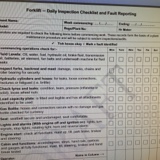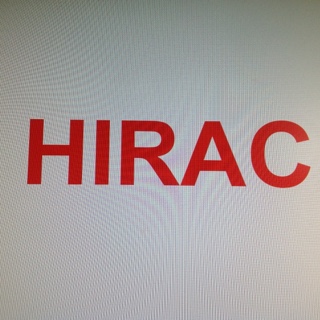Audit / Inspection Details
-
Title of Worksite Inspection
-
Inspected by
- Thomas Koehler
- Andrew Rouen
- Terry Allen
- Taila Johnston
- Simon Crocker
- Sharon Farley
- Matthew Leziak
- Matt Madlener
- Evi Waldron
- Ee Hobbs
- Peter Brunt
-
Audited/Inspected by:
-
Location inspected
-
Date and time
Worksite Inspection
-
Hazard Identification Risk Rating and Risk Control
HIRAC
-
Hazard identification risk rating (Add note, take picture and risk rate)
-
Recommended control
1. Floors
-
No slip, trip or fall hazards
-
Apertures or openings in floor
-
Clean, orderly and free from grease grease hazards?
-
No standing water on floors?
-
Grates covering drains are in place?
-
Nonslip surfaces wherever possible?
2. Aisles
-
Clearly marked?
-
Unobstructed and sufficient room?
-
Corners unobstructed to offer clear view
-
Sufficiently wide for material handling?
3. Stairs
-
Uniform hight and tread depth?
-
Is there grating type tread on exterior stairs?
-
Are there platform levels to break long flight of stairs?
-
Are the stair treads at least 56mm wide?
-
Materials and equipment not stored on stairs?
-
Are there sturdy railings on all sides of steps and platforms?
-
There is adequate lighting for stairs?
-
Are the stair treads non-slip?
-
No worn or damaged stair treads?
4. Lighting
-
Is the Illumination level sufficient for work performed?
-
Is there task lighting on close vision jobs?
5. Emergency Preparedness and Exits
-
Emergency exits adequately illuminated?
-
No locked or barred exits restricting escape?
-
Emergency exits clear for prompt exit?
-
Emergency exit locations clearly marked and illuminated (if required)?
-
Exterior exit doors open outwards?
-
Written and posted emergency evacuation plan with exit maps for all areas provided?
-
Emergency assembly location shown on plan and diplayed at site?
6. Ventilation
-
Is there adequate ventilation for the process?
-
Are there exhausts in place and working?
-
Vacuume extraction units to clear air?
-
Cooling fans or airconditioning where required for staff comfort?
-
In working and maintained regularly?
-
All fans properly guarded?
7. Noise Control
-
Are workers provided pre-employment hearing tests to establish an baseline?
-
Have all areas been assessed for the presence of harmful noise levels?
-
Are all workers in the presence of harmful noise levels wearing hearing protection?
-
Are noise hazard locations identified by safety signs or stickers?
-
Are noise barriers in place for high level noise exceeding exposure standard of LAeq, 8 hrs @ 85dB?
8. Portable Power Tools
-
Workers properly trainined in the use of power tools?
-
Are on and off switches working properly?
-
Are power tools in good condition e.g. leads?
-
Are all guards in place?
-
Is hearing protection worn if over 85dB?
-
Are adequate storage facilities provided?
9. Electrical
-
Is electrical equipment tagged and tested for currency?
-
Is the site shed protected by Residual Current Device (RCD) Electrical circuit breaker?
-
Are power boards used (no double adaptors or piggy backs)?
-
Do portable power tools have RCDs?
-
Are leads inspected daily for damage (Hostile environment)?
10. Plant / Machines e.g. Guarding
-
All guard in place, secure and in good condition?
-
Operating controls locked when not in use or tool idle?
-
Pinch points and crushing points guarded or warning stickers attached to keep clear when in operation?
-
Emergency stop buttons readily accessible and operable?
-
Eye protection provided where needed?
-
Hearing protection provided where noise exceeds 85dB?
-
Guards provided for directing spark or arrest/chips from rotating equipment
-
Operators are trained and competent in the safe operation of plant?
-
Is evidence of training provided to operators?
11. Hoisting and Lifting Equipment
-
Load capacity identified
-
Overhead guards in place?
-
Limit stops working effectively?
-
Special area for refuelling and recharging batteries?
-
All controls and foot controls operational?
-
Operators are trained and competent in the safe operation of plant?
12. Tag-out / Lockout
-
Do operators understand the initial tag-out procedure?
-
Are there SWPs for Isolation, tag-out and lock-out.
-
Are all locks issued to a person keyed identically?
-
Are tags available in the machine or location?
-
Do mechanics apply their own locks when working on machinery?
-
Are operators notified of return to service?
13. Plant Exclusion Zone
-
Signs and barricades in place to identify exclusion zone?
-
Pedestrian walkways provided to delineate plant from people?
14. Industrial / Forklift Trucks
-
All operators trained and licensed with a High Risk Work Licence (HRWL)?
-
Checklist available and completed prior to operating forklift (Pre-shift)?
-
Load capacity labelled?
-
Overhead guards and load backrest in place?
-
Operator travels at safe speed for location (or follows speed limit)?
-
Fork tynes in good condition?
-
Pedestrian given right of way?
-
Operator disciplined/removed for unsafe operation of forklift?
15. Receiving and In-Plant Materials and Handling
-
Freight delivered within regulated hours e.g. delivery drivers not pressured to deliver earlier than regulated driving hoours?
-
Traffic control considered when unloading or loading materials e.g. spotter, witches hats, bollards or bunting?
-
Loading and unloading conducted by a licensed and competent operator?
-
Pallets in good condition?
-
Goods stored in designated locations?
-
Hazardous goods e.g. chemicals properly stored and bunded where required?
16. Environmental Controls
-
Is there an environmental plan in place?
-
Are work practices designed to reduce impacts to the environment?
-
Does the company have a recycling policy?
-
Are procedures available for the disposal of waste and used hazardous substances E.g. Safety Data Sheets?
-
Are all locations rehabilitated to meet EPA standard?
-
Bin location prominent, adequate and emptied regularly?
-
All materials removed from sites?
-
No litter strewn around site ?
-
Laydown (repairs and maintenance) areas defined with fluids properly disposed of?
-
All quarantined organic materials contained onsite?
17. Hazardous Substances (Chemicals) - Code of Practice for Hazardous Substances
-
Are hazardous materials identified and control measures implemented?
-
Are Safety Data Sheets available for all substances used in the workplace?
-
Are all safety data sheets current (not over 5 years old)?
-
Have risk assessments been conducted to eliminate or minimise the type of chemicals used?
-
Are workers trained in the safe handling and application of hazardous chemicals?
-
Do workers follow SDS procedures when handling chemicals?
-
Are chemicals stored properly ( E.g. 110% bunded and in-compatible separation)?
-
Are all containers used for handling chemicals labeled correctly?
-
Is the product identified correctly?<br>- Australian address, business telephone number and manufacturer / import identified?<br>- hazardous chemical pictograms consistent with correct classification?<br>
-
Are first aid treatment and emergency procedures available relevant to the chemical?
-
Do workers using hazardous chemicals require health monitoring (Refer chemical)?
-
Are workers wearing PPE as prescribed by the safety data sheet (SDS) for chemical used?
18. Hotwork
-
Permit to conduct hot work (Usually encompasses a risk assessment)?
-
Risk assessments conducted where hot work presents a risk?
-
Is fire fighting equipment available for fire prone locations?
-
Are flammables or explosive substances removed from location prior to hot work?
-
Spotter available if required within permit?
-
Is correct PPE being worn for task?
-
Welding screens and fire blankets in place?
19. Gas Cylinders (Oxygen and Acetylene etc)
-
Are gas cylinder properly stored (chained and secured)?
-
Gas cylinders properly turned off and hoses wound up?
-
PPE available and used for welding or oxy cutting?
-
Cylinders secured, gauges operative, flashback arresters fitted and hoses in good condition?
-
LPG - Is the LPG cylinder stamped as current (Within 5 years) and in serviceable condition?
20. Portable Ladders
-
AS/NZS 1892 Portable Ladder (industrial standard)?
-
Load rating of 120kg?
-
Is the ladder secure at top and bottom?
-
Does ladder extend 900mm to 1 metre above the landing platform?
-
Fall protection at stepping of point e.g. rails or harness and anchor points to 15 kilonewton for single person?
-
Are temporary ladders not > 6 metres between successive ladder landings?
-
No metal ladders near electrical areas?
-
Only one person at a time on a ladder e.g. causing unsafe work practices?
-
Danger do not use tags available for defective ladders and other equipment?
21. Mechanical Equipment
-
Operating manuals and safework procedures available?
-
Pre-operational chekcs carried out on equipment e.g. not damaged and safe for operation?
-
Equipment manitained and serviced regularly?
-
Servicing records kept and available?
-
Operators trained and competent?
-
Emergency stops fully functional?
22. Power Systems - Hydraulic
-
Hoses checked for nicks, dents, leaks, wear and damage?
-
Pressure regulated within limits?
23. Power Systems - Electrical
-
Electrical control panels clearly identified and secured?
-
Only certified electrician to have access to panels (unless minor)?
-
Grounding tested?
-
Any exposed conductors at rear of switchboard?
-
Electrical equipment tagged and tested where required?
24. Biological Hazards
-
Biological hazards identified including seasonal?
-
Personal protective equipment provided?
-
Emergency contacts displayed?
-
Hand washing facilities available?
-
Disposable and reusable sharps placed in a puncture resistant, leak proof container with BIOHAZARD label?
-
Disposable containers available for disposable PPE?
-
Workers instructed in the proper way to remove PPE to minimise contamination?
-
Bins, cans and other receptacles intended for reuse, decontaminated on a regular basis?
25. Fire Protection
-
Fire hoses checked, readily accessible, and inspected monthly?
-
Fire equipment provided to Australian Standards?
-
Regular fire drill conducted e.g. at minimum every 6 months
-
Fire drill records kept?
26. Personal Protective Equipment
-
Hair nets and coveralls provided to avoid contamination?
-
Correct gloves provided for types of tasks e.g. as per SDS?
-
Eye and face protection provided specific to task?
-
Head protection available where there is risk of a head injury?
-
Foot protection properly selected for each task
-
Aprons provided for spectific tasks
-
Respiratory protection available and properly seleced for tasks?
-
Emergency eye baths and showers readily available and accessible?
-
Proper signage and instructions provided for PPE?
-
PPE stored properly?
27. First Aid
-
Signs located where stored?
-
Medical supplies provided to suit type of injuries that may be incurred?
-
Trained first aiders on-site?
-
First aider names displayed?
-
Injuries and incidents reportted and documented?
28. Food Waste
-
Special containers provided for different types of waste, oily rags, chemicals, scrap paper, garbage waste, medical waste, blood borne pathogen waste and biological waste?
-
Food waste recycled?
-
Where required, waste properly labelled?
-
Approved disposal of hazardous waste available?
29. Offices
-
Stations set-up ergonomically for staff
-
Staff conduct periodic stretching exercises?
-
Staff take regulated rest breaks?
-
Electrical leads properly arranged e.g. not causing trip hazards?
-
Materials stored properly?
-
Small pad with hand rail type step ladders available to workers for equipment, books stored above shoulder height?
-
Adequate ventilation e.g. fans or air-conditioning provided for worker comfort?
30. Confined Space
-
Workers are trained in confined space awareness where required?
-
Confined space areas identified?
-
If confined space identified, workers are confined space trained?
-
Gas detector available and workers are trained in the use of gas detectors?
-
Confined space entry permit completed if identified as a confined space?
-
Life lines, harness and repirators available?
Inspected by (Name, comments and signature)
-
Inspection team (names)
- Thomas Koehler
- Andrew Rouen
- Terry Allen
- Taila Johnston
- Simon Crocker
- Sharon Farley
- Matthew Leziak
- Matt Madlener
- Evi Waldron
- Ee Hobbs
- Peter Brunt
-
Comments and overall rating
-
Name and signature of person conducting worksite inspection














